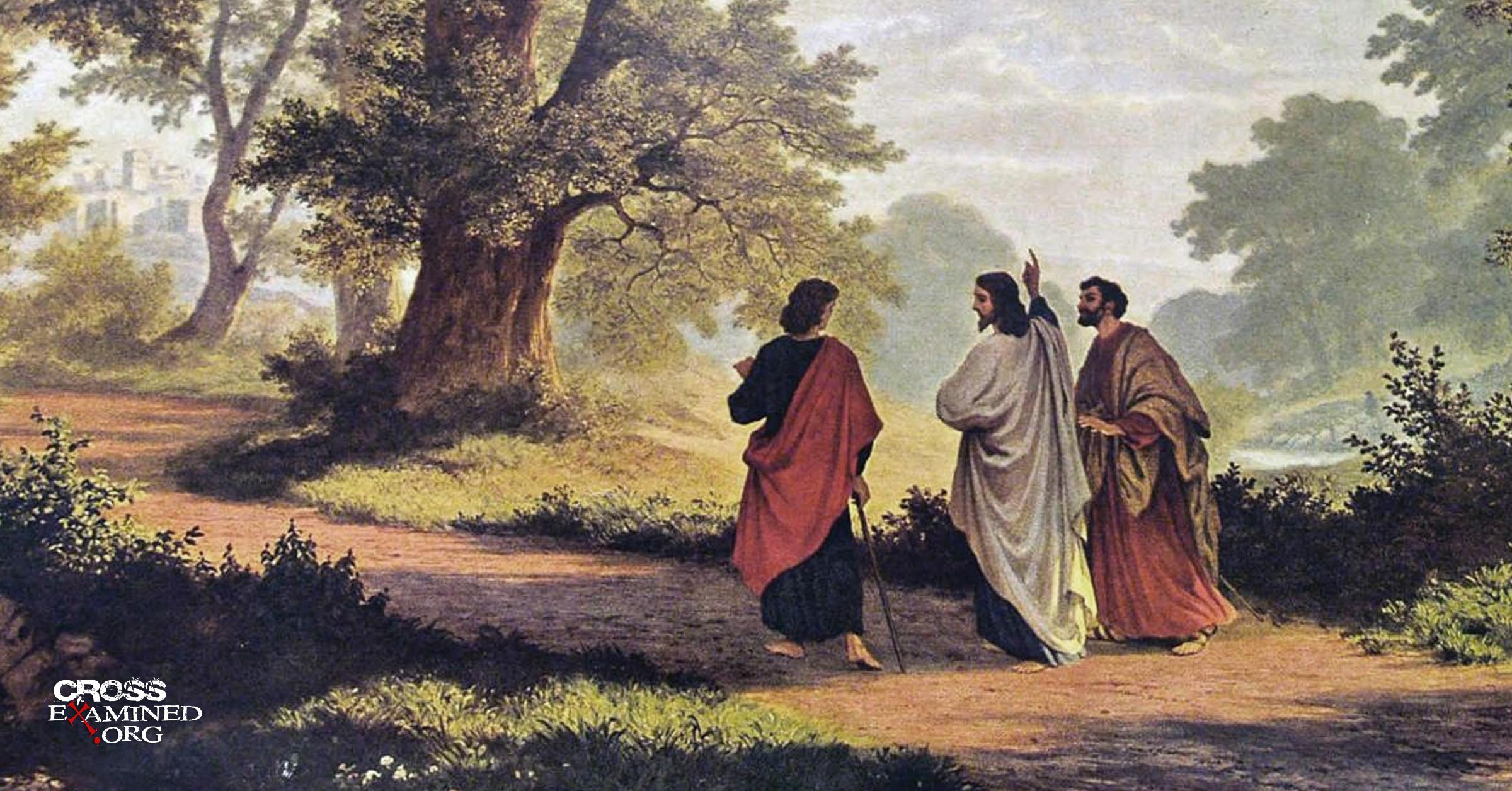Messianic Convergence in the Gospels: A New Way to Frame the Argument from Old Testament Fulfilment
Anyone who has spent considerable time studying the gospels can tell that they are literally saturated with Old Testament fulfilment and allusions. Indeed, the early church used two primary lines of argument to establish the Messianic credentials of Jesus of Nazareth — the resurrection of Jesus from the dead and Messianic prophecy. How useful is fulfilment of the Messianic prophecy in the person of Jesus to the purposes of contemporary, twenty-first-century apologists? In this article, I explore a way to frame the argument in a robust and objective way. First, I will summarise my argument, and then I will dig into the details.
A Summary of the Basic Argument
When it comes to the origins of the gospel narratives, there are three contending hypotheses for explaining their origin. These are:
(1) The gospel authors deliberately fabricated the events that they narrate.
(2) The gospel authors were honestly mistaken in their reporting of the events that they narrate.
(3) The gospel authors faithfully recorded actual events.
Of course, those options could in principle, be correct either individually or in combination with one another. When we discover striking correlations between the gospel narratives and the Old Testament texts (on a level that is unlikely by mere coincidence), then we have evidence against the hypothesis that the gospel authors were honestly mistaken — that is to say, we have positive evidence for design, either on the part of the human authors manipulating the story to impose conformity to the Hebrew Scriptures or on the part of God supernaturally orchestrating the history. The question then becomes, what is the locus of the design?
The first of the above hypotheses — that is, that the gospel authors deliberately fabricated the events that they narrate is significantly undermined when we discover points of historical confirmation of the gospels (a subject that I have written, lectured and debated extensively about elsewhere). I have contended publicly elsewhere that numerous historical points in the gospels can be historically verified and confirmed (e.g., here). This gives rise to an inductive argument for treating the gospel documents as a whole as trustworthy. The numerous points of historical confirmation in the book of Acts, moreover, build us a picture of the pedigree of its author Luke (who also happens to be the author of the third gospel), and thus offers us additional reason to trust what he writes in his gospel. I (and others) have developed that case extensively in various venues, and to argue this is not the primary purpose of the present article.
Having shown the first two of the three options to be improbable, therefore, it is possible to provide evidential support for the third contending hypothesis, namely, that the gospel authors faithfully recorded actual events, and the locus of the design is supernatural divine orchestration of the events to result in convergence between events in Jesus the Messiah’s life and foreshadows written of in the Hebrew Bible. In syllogistic form, this argument can be presented as follows:
Premise 1: The correlation between events recorded in the gospels and Hebrew Scripture is either the product of human design or divine design.
Premise 2: It is not the product of human design.
Conclusion: Therefore, it is the product of divine design.
One can, of course, make the inductive argument I just described for taking the gospels as a whole to be highly reliable. The case, however, is lent even greater force when we can point to specific instances of details in the gospels that are subject to historical confirmation, which also correlates with the Hebrew Bible in some way. We can model this argument probabilistically using Bayesian analysis.
Probabilistic Modelling
The equation given below represents the odds form of Bayes theorem, which is used in developing cumulative cases. Translated, it states that the posterior probability of your hypothesis (H) given the available evidence (E) is equal to the prior probability (given the background information) of the hypothesis being true (expressed as a ratio) multiplied by the ratio of the evidence given the hypothesis against the probability of the evidence given the antithesis.
Dividing the probability of the evidence given the hypothesis by the probability of the evidence given the antithesis gives you what is referred to in probability theory as the Bayes Factor. The Bayes Factor is a measure of the strength of the evidence and indicates how many times more likely it is that you will observe this evidence given that your hypothesis is true than if it were false. For instance, a Bayes Factor of one hundred indicates that your evidence is one hundred times more likely if your hypothesis is true than if it were false.
This form of reasoning is used routinely in the discipline of forensic science. For instance, the presence of a defendant’s fingerprints on the murder weapon may be taken as evidence for the hypothesis of guilt over the hypothesis of non-guilt because the probability of the defendant’s fingerprints being on the murder weapon is much higher on the hypothesis that the defendant is guilty than on the hypothesis that he is not guilty. This is the very same mode of reasoning that I use when evaluating the evidence for the existence of God and for the truth of the Christian gospel. As we examine the data, I will be using to construct this argument; we will assign each a plausible Bayes factor as a way of modeling our cumulative case. We will then be able to more readily see the strength of the argument as a whole. Please note that there is a degree of subjectivity in these assignments, but I have tried as best as I can to err on the side of caution, and I do not think my estimates are unreasonable. In any case, the reader is invited to plug in his or her own numbers and conduct their own analysis. My goal here is to show how an argument of this sort can be mounted.
The Data
I will now consider several instances where we have specific historical confirmations of details in the gospel that, given the Old Testament backdrop, seems to be a bit too striking to be coincidental.
Example #1: Jesus’ Death at Passover
One historical detail that can scarcely be denied is that Jesus died at the time of Passover. This is a detail attested by all four gospels and implied by Paul in 1 Corinthians 5:7. This is not a detail that the gospel authors (or their sources) plausibly misremembered. So many details in the gospels are connected to Jesus’ death being at the time of Passover (e.g., see John 18:28). It is also supported by the next example we will discuss shortly. I will not here get into the discussion of whether John and the synoptic gospels contradict each other on the precise day on which Jesus is crucified (I have already addressed that here). It is clear that the New Testament authors unanimously considered Jesus to be the ultimate fulfilment of the Passover lamb (see John 1:29; John 1:36; 1 Corinthians 5:7; 1 Peter 1:18-19; Revelation 7:14; and Revelation 12:11). The correspondence, therefore, seems too neat to be the result of coincidence. Christ’s execution by the Romans at the time of Passover is a remarkable ‘coincidence’ that would have been difficult for an impostor to engineer.
One caveat to consider is that there are also other days throughout the year, such as the day of atonement, to which we might attach some special significance if Jesus’ death had landed on those days. I will, therefore, assign a conservative Bayes factor of 50 for this correspondence. Remember, this means that the correlation is 50 times more probable on the hypothesis of design than on the hypothesis of coincidence.
Example #2: Selection of the Passover Lamb
There is an additional interesting connection, not wholly independent of the one just discussed but nonetheless certainly worthy of attention. This has to do with Jesus’ entrance into Jerusalem five days before the Passover on which He died. Consider John 12:1-2,12-13:
Six days before the Passover, Jesus, therefore, came to Bethany, where Lazarus was, whom Jesus had raised from the dead. 2 So they gave a dinner for him there. Martha served, and Lazarus was one of those reclining with him at the table…12 The next day the large crowd that had come to the feast heard that Jesus was coming to Jerusalem. 13 So they took branches of palm trees and went out to meet him, crying out, “Hosanna! Blessed is he who comes in the name of the Lord, even the King of Israel!”
John here has given us a very specific extraneous detail (which none of the other gospels gives us): Jesus arrived at Bethany six days before the Passover, and the following day rode into Jerusalem on the back of a donkey (which would have been five days before the Passover).
Can we confirm John’s accuracy on this? Yes, we can.
Turn over to Mark 11:1-11, which parallels the arrival at Bethany (although Mark does not give us the time-stamp that John provides):
Now when they drew near to Jerusalem, to Bethphage and Bethany, at the Mount of Olives, Jesus sent two of his disciples 2 and said to them, “Go into the village in front of you, and immediately as you enter it you will find a colt tied, on which no one has ever sat. Untie it and bring it…7 And they brought the colt to Jesus and threw their cloaks on it, and he sat on it. 8 And many spread their cloaks on the road, and others spread leafy branches that they had cut from the fields. 9 And those who went before and those who followed were shouting, “Hosanna! Blessed is he who comes in the name of the Lord! 10 Blessed is the coming kingdom of our father, David! Hosanna in the highest!” 11 And he entered Jerusalem and went into the temple. And when he had looked around at everything, as it was already late, he went out to Bethany with the twelve.
Mark does not tell us that Jesus approached Bethany six days before the Passover, nor that it was the following day that Jesus rode into Jerusalem. However, it appears implicit that they fetched the colt early in the morning — since the disciples fetch the colt, there is the triumphal entry and Jesus and the disciples entered the temple and “looked around at everything” (which was presumably a whole day’s activities). If then, we assume that Jesus entered Jerusalem five days before Passover, then we can begin counting off the days narrated in Mark’s gospel, to see if the narrative synchronizes with that of John.
Verses 12-14 narrate the cursing of the fig tree, which according to verse 12, happened “the following day” (i.e., four days before the Passover, assuming John’s chronology to be correct). Jesus then cleansed the temple, and according to verse 19, “when evening came, they went out of the city.” In verse 20, we read, “As they passed by in the morning, they saw the fig tree withered away to its roots.” We are now, therefore at three days before the Passover. In Mark 13, we read of the Olivet discourse on the Mount of Olives. This we can assume took place in the evening, since the Mount of Olives was mid-way between the temple in Jerusalem and Bethany where Jesus and the disciples were staying. This, then, marks the end of three days before the Passover. When we turn over to Mark 14, we read in verse 1, “It was now two days before the Passover.” Mark and John thus calibrate perfectly, thereby corroborating the time-stamp given to us by John.
Having confirmed that Jesus really did enter Jerusalem five days before the Passover, let us now look to the Old Testament to see if we have any point of striking correlation. Passover itself falls on the fifteenth day of the month of Nisan. That means that five days before the Passover falls on the 10th day of Nisan. Now let us turn over to Exodus 12, where God gives instructions to the people of Israel concerning the first Passover. In verse 3, God says to Moses and Aaron,
Tell all the congregation of Israel that on the tenth day of this month [i.e., Nisan] every man shall take a lamb according to their fathers’ houses, a lamb for a household.
Thus, the Passover lamb was to be selected and taken into the household of the men of Israel on the tenth day of the month of Nisan. Given the oft-repeated New Testament imagery of Jesus being the Passover lamb (e.g., 1 Corinthians 5:7), it is thus quite striking that Jesus’ triumphal entrance into Jerusalem and reception by the people happens to fall on the 10th of Nisan, five days before Passover.
How probable is this correlation on the hypothesis that the connection is coincidental? It must be borne in mind that this coincidence is not wholly independent of the previous one since Jesus coming into Jerusalem on Nisan 10 would not matter at all if it weren’t for the fact that he then died subsequently at least around that time. If we take his entry into Jerusalem on Nisan 10 to be significant, we must be assuming that he died right around that time, which means that that one entails the other. The question we can ask, however, is how much additional evidence it provides that Jesus also entered Jerusalem on Nisan 10. Another factor for us to consider is that Passover is a particularly likely time for a Jew to enter Jerusalem and also a time when he could count on ministering to a large crowd of people who had made their pilgrimage to Judea for the feast.
One may object here that a possible explanation of this coincidence is that Jesus Himself, seeing Himself as the fulfilment of the Passover lamb, deliberately entered Jerusalem on Nisan 10th. However, to this, I offer two responses. First, if Jesus saw falsely Himself as Messianic it is far more likely that he would have perceived Himself to be a military leader like Simon Bar Giora, who would lead a revolt against the Roman occupiers, not suffer a humiliating death by crucifixion. Second, the appropriate issue to concern ourselves with is the striking coincidence that it was precisely on the year on which Jesus entered Jerusalem five days before Passover that His death by crucifixion coincidentally took place on the day of Passover.
To be conservative, therefore, I will only assign a Bayes factor of 2 to this fact. Thus far, our cumulative Bayes factor from the two examples we have considered is 50 x 2 = 100.
Example #3: Jesus the First Fruits
In 1 Corinthians 15:20, Paul says of Christ that he is “the firstfruits of those who have fallen asleep.”
What is being alluded to here? For the answer, we turn to Leviticus 23:9-14, in which we read of the feast of first fruits.
9 And the Lord spoke to Moses, saying, 10 “Speak to the people of Israel and say to them, When you come into the land that I give you and reap its harvest, you shall bring the sheaf of the firstfruits of your harvest to the priest, 11 And he shall wave the sheaf before the Lord, so that you may be accepted. On the day after the Sabbath, the priest shall wave it. 12 And on the day when you wave the sheaf, you shall offer a male lamb a year old without blemish as a burnt offering to the Lord. 13 And the grain offering with it shall be two-tenths of an ephah of fine flour mixed with oil, a food offering to the Lord with a pleasing aroma, and the drink offering with it shall be of wine, a fourth of a hin. 14 And you shall eat neither bread nor grain parched or fresh until this same day until you have brought the offering of your God: it is a statute forever throughout your generations in all your dwellings.
The feast of firstfruits is the next Jewish feast following the feasts of Passover and unleavened bread and had to do with the barley harvest, which preceded the slightly later wheat harvest (the former arrived in March / April; the latter around May, according to our calendars). The latter of those was associated with the feast of Weeks (Pentecost). God, therefore, instructed the people of Israel that prior to reaping the barley harvest they were to wave before the Lord a sheaf of the first grain. This would symbolize that the sheaf was representative of the whole crop. It represented their trust that the God who had given them the firstfruits would also bless the rest of the harvest.
How, then, does Paul, in 1 Corinthians 15:20, link Jesus to the feast of first fruits? Christ was the first fruits of the resurrection, having been raised prior to the general resurrection at the end of time. Although previous people (e.g., Lazarus, Jairus’ daughter) had been raised from death, those individuals were not raised to glory and immortality. Eventually, they would die again. Jesus, by contrast, was the first person in all of history to be raised to glory and immortality, with a body transformed such that it was no longer subject to decay or death. Thus, he is the ‘sheaf’ that is waved before the Lord, the first fruits of the harvest.
Now, what is particularly striking is the day on which the feast of first fruits was to take place. According to Leviticus 23:11b, it was to happen “the day after the Sabbath” following Passover. That would be Sunday! It can thus hardly be a coincidence that Christ was raised on the Sunday following the Passover. When we consider the day that Jesus was claimed to be raised as first fruit from among the dead (the Sunday following Passover), we have yet another striking coincidence.
It is largely taken for granted among scholars that the disciples had experiences following Jesus’ death, which they interpreted to be the raised Christ — scholars are largely in agreement that the disciples did not deliberately lie about having seen Jesus raised from the dead. We also have strong evidence that the claim was that Jesus rose from the dead on the Sunday following His crucifixion — not only is it reported in all four gospels (Matthew 28:1, Mark 16:2, Luke 24:1, John 20:1), but there is also the widespread switch from observing the Sabbath to observance of the Lord’s day (Sunday) in the first century. One might object that the gospels only report the discovery of the empty tomb and the appearances taking place on the Sunday but do not tell us when exactly Jesus was raised. However, Jesus repeatedly states that His resurrection will take place “on the third day,” which would have to be the Sunday since His death was on a Friday. Further evidence that the earliest apostolic proclamation was that Jesus had been raised on the Sunday following His death is the allusion in 1 Corinthians 15:4 to Jesus being “raised on the third day in accordance with the Scriptures.” Indeed, Paul’s allusion in verse 20 of the same chapter to Christ being the firstfruits from among the dead may indicate what Paul means by Christ’s resurrection on the third day being “in accordance with the Scriptures.”
It must be stated at this point that the exact interpretation of Leviticus 23:11b was disputed by first-century Jewish interpreters. Most Pharisees took this day to be the day after the annual Sabbath, rather than the weekly Sabbath — that is, the day after the 15th of Nisan, on which fell the feast of unleavened bread (the Jews were not permitted to work on this day according to Leviticus 23:7). They would thus observe the firstfruits offering on the 16th of Nisan, irrespective of the day of the week. Here is what the first-century Jewish historian Flavius Josephus tells us [Antiquities 3:10:5-6]:
But on the second day of unleavened bread, which is the sixteenth day of the month, they first partake of the fruits of the earth, for before that day, they do not touch them.
A minority of Pharisees, and the Sadducees, however, maintained that the offering of first-fruits was to take place the day after the weekly Sabbath which falls during the feast of unleavened bread. According to this view, the firstfruits offering always took place on a Sunday. This view makes more sense to me Biblically because Leviticus 23:15-16 gives the following instruction about when the feast of firstfruits is to be observed:
15 “You shall count seven full weeks from the day after the Sabbath, from the day that you brought the sheaf of the wave offering. 16 You shall count fifty days to the day after the seventh Sabbath. Then you shall present a grain offering of new grain to the Lord.
For the day after the seventh Sabbath to equal exactly 50 days, one has to begin counting from the day after the weekly Sabbath.
Furthermore, according to the gospels, the day following Jesus’ death was itself a weekly Sabbath. For example, in John 19:31, we are told,
Since it was the day of Preparation, and so that the bodies would not remain on the cross on the Sabbath (for that Sabbath was a high day), the Jews asked Pilate that their legs might be broken and that they might be taken away.
Likewise, Mark 15:42-43 tells us,
42 And when evening had come, since it was the day of Preparation, that is, the day before the Sabbath, 43 Joseph of Arimathea, a respected member of the council, who was also himself looking for the kingdom of God, took courage and went to Pilate and asked for the body of Jesus.
The festival of first fruits, therefore, would have to have been celebrated the day following the Sabbath (given the Jewish regulations about what could or could not be performed on the Sabbath). This entails that the Sunday on which Jesus was raised is indeed the feast of first fruits.
Moreover, as long as the second temple stood (i.e., prior to A.D. 70) and the Sadducees were in charge, their interpretation prevailed, and the feast of firstfruits was recognized the day following the first weekly Sabbath after Passover.
Further evidence that the gospel authors understood Jesus to be fulfilling the first fruits comes from Acts 2, where we read that the Holy Spirit comes upon the disciples at the time of Pentecost, which fulfils further symbolism relating to the feast of Pentecost that is outlined in Leviticus 23 (which I will not dwell upon here).
What Bayes factor might we assign to this piece of evidence? Of course, this piece of evidence is not wholly independent of the fact that Jesus’ death takes place at the time of Passover. There are also only seven days in the week. For these reasons, I assign a conservative Bayes factor of 5. So far, our cumulative Bayes factor is 50 x 2 x 5 = 500.
Example #4: The Crucifixion
Psalm 22 contains a remarkable text which, centuries before crucifixion was even invented, contains a description of the Messiah’s sufferings that strikingly resemble a crucifixion scene. Consider this excerpt from verses 12-18:
12 Many bulls encompass me; strong bulls of Bashan surround me; 13, they open wide their mouths at me, like a ravening and roaring lion. 14 I am poured out like water, and all my bones are out of joint; my heart is like wax; it is melted within my breast; 15 my strength is dried up like a potsherd, and my tongue sticks to my jaws; you lay me in the dust of death. 16 For dogs encompass me; a company of evildoers encircles me; they have pierced my hands and feet— 17 I can count all my bones— they stare and gloat over me; 18 they divide my garments among them, and for my clothing they cast lots.
Dislocation of bones, heart failure, lack of strength, dehydration, and the piercing of the hands and feet are all apt descriptions of a crucifixion scene, not to mention the dividing of his garments and the casting of lots — crucifixion victims would be stripped naked as part of their humiliation. This execution also appears to be public since people stare and gloat over him. For a much more detailed description of the evidence for the Messianic nature of this text, I refer interested readers to Mike Winger’s video on the subject of Psalm 22, or this discussion between Dr. James White and Dr. Michael Brown on the topic. The Messianic interpretation of Psalm 22 is also not a Christian invention but can be found in early Jewish sources (for documentation, see this article).
For this fact, I think it is fair to assign a conservative Bayes factor of 1000 (for justification of this Bayes factor, see McGrew, L. (2013) Probabilistic Issues Concerning Jesus of Nazareth and Messianic Death Prophecies. Philosophia Christi 15:311-328.
Thus far, our cumulative Bayes factor is 50 x 2 x 5 x 1000 = 500,000
Example #5: The Name Jesus
The name Jesus is itself very significant. The reason for calling him Jesus is given in Matthew 1:21:
…you shall call his name Jesus, for he will save his people from their sins.
Fittingly, Jesus’ name (the same name as Joshua) means “Yahweh is salvation.” Already, this is a striking coincidence.
A second reason why the name Jesus is significant is that a certain Joshua in the Old Testament replaces Moses in leading God’s people into the promised land. Moses represents the embodiment of the law. The law (embodied by Moses) was unable to lead God’s people into the promised land and so was replaced by Joshua.
A third correspondence is to another Joshua in the book of Zechariah and chapter 6. In Zechariah 6:9-13, we read,
9 And the word of the Lord came to me: 10 “Take from the exiles Heldai, Tobijah, and Jedaiah, who have arrived from Babylon, and go the same day to the house of Josiah, the son of Zephaniah. 11 Take from them silver and gold, and make a crown, and set it on the head of Joshua, the son of Jehozadak, the high priest. 12 And say to him, ‘Thus says the Lord of hosts, “Behold, the man whose name is the Branch: for he shall branch out from his place, and he shall build the temple of the Lord. 13 It is he who shall build the temple of the Lord and shall bear royal honor and shall sit and rule on his throne. And there shall be a priest on his throne, and the counsel of peace shall be between them both.”’
This individual is described as “the man whose name is the Branch,” which is a Messianic title used elsewhere (e.g., Zechariah 3:8; Isaiah 11:1; Jeremiah 23:5; Jeremiah 33:15). He is also given the office of both priest and king, a dual office which the Messiah is also said to fulfil (e.g., Psalm 110:4) whereas others were not permitted to occupy both offices.
In a study of 2625 male Jewish names from first-century Palestine (from documentary sources and ossuaries), 99 are reported to bear the name Jesus/Joshua (it being the sixth most popular name). That is approximately 3.77% of the Jewish male population. I will conservatively assign a Bayes factor to this piece of evidence of 2, taking our cumulative Bayes factor to 50 x 2 x 5 x 1000 x 2 = 1000,000.
Example 6
Yet another striking coincidence is the fact that Christianity became the dominant international world religion that it became. Until 313 A.D., the Christian church was the persecuted minority, and powerful rulers and officials attempted to stamp out the Christian religion, destroy its Scriptures and its people. There was a high price to pay for being a follower of Jesus, and your fate could include being nailed to a cross, burned alive, or fed to wild animals. The probability that Christianity would become a dominant global religion was, therefore, vanishingly small. However, this is exactly what was predicted in various passages throughout the Old Testament, namely, that the Messiah would bring representatives of all nations to a recognition and worship of the God of Israel.
As an example, consider Isaiah 49:6:
He says: “It is too light a thing that you should be my servant to raise up the tribes of Jacob and to bring back the preserved of Israel; I will make you as a light for the nations, that my salvation may reach to the end of the earth.”
Therefore, on the hypothesis that a given individual is the promised Messiah, the probability that they would bring representatives of all nations of the world to worship the God of Israel is approximately equal to one, whereas on the hypothesis that Jesus is not the Messiah, the probability is vanishingly small. In all history, only Jesus has accomplished this fete. I will assign a conservative Bayes factor of 1000.
At this point, our cumulative Bayes factor is 50 x 2 x 5 x 1000 x 2 x 1000 = 1000,000,000
Conclusion
Various other examples could be given, but I will stop the present analysis at this point. The point of this article was simply to show how a cumulative case can be constructed for the truth of Christianity based upon these striking instances of convergence between the life of Jesus and Old Testament texts in a manner that seems to point towards the conclusion of design rather than coincidence. Since the examples given above enjoy strong historical corroboration, we can safely rule out the human design as being responsible for these correspondences. We, therefore, have good evidence for divine design, and therefore the truth of Christianity.
Of course, it is necessary when doing a Bayesian analysis to give an estimate of the prior probability. Prior probability relates to the intrinsic plausibility of a proposition before the evidence is considered. Normally the prior probability will be somewhere between zero and one. A prior probability of one means that the conclusion is certain. For instance, the fact that two added to two is equal to four has a prior probability of one. It is true by definition. A prior probability of zero, conversely, means that the hypothesis entails some sort of logical contradiction (such as the concept of a married bachelor) and thus cannot be overcome by any amount of evidence. Priors can be established on the basis of past information. For example, suppose we want to know the odds that a particular individual won last week’s Mega Millions jackpot in the United States. The prior probability would be set at 1 in 302.6 million since those are the odds that any individual lottery participant, chosen at random, would win the Mega Millions jackpot. That is a low prior probability, but it could be overcome if the supposed winner were to subsequently quit his job and start routinely investing in private jets, sports cars, and expensive vacations. Perhaps he could even show us his bank statement or the documentary evidence of his winnings. Those different pieces of evidence, taken together, would stack up to provide powerful confirmatory evidence sufficient to overcome a very small prior probability to yield a high posterior probability that the individual did indeed win the Mega Millions jackpot. In other situations, setting an objective prior is more tricky, and in those cases, priors may be determined by a more subjective assessment.
If we suppose for argument’s sake that the prior probability of God sovereignly orchestrating the history is as low as 1 in 10,000,000, this leads us to a posterior probability of 0.99 of the hypothesis being true. Of course, this figure will be highly dependent on the Bayes Factors we have assigned to each piece of evidence. This is, of course, only a mathematical tool for modelling how a cumulative case can provide powerful evidence for our hypothesis, and we haven’t even considered all of the relevant data. I invite readers to plug in their own numbers and see what conclusion they arrive at.
Recommended resources related to the topic:
The Jesus of the Old Testament in the Gospel of John mp3 by Thomas Howe
How Can Jesus be the Only Way? (mp4 Download) by Frank Turek
Cold Case Resurrection Set by J. Warner Wallace (books)
World Religions: What Makes Jesus Unique? mp3 by Ron Carlson
The Bodily Nature of Jesus’ Resurrection CD by Gary Habermas
Historical Evidences for the Resurrection (Mp3) by Gary Habermas
How to Interpret Your Bible by Dr. Frank Turek DVD Complete Series, INSTRUCTOR Study Guide, and STUDENT Study Guide
Dr. Jonathan McLatchie is a Christian writer, international speaker, and debater. He holds a Bachelor’s degree (with Honors) in forensic biology, a Master’s (M.Res) degree in evolutionary biology, a second Master’s degree in medical and molecular bioscience, and a Ph.D. in evolutionary biology. Currently, he is an assistant professor of biology at Sattler College in Boston, Massachusetts. Dr. McLatchie is a contributor to various apologetics websites and is the founder of the Apologetics Academy (Apologetics-Academy.org), a ministry that seeks to equip and train Christians to persuasively defend the faith through regular online webinars, as well as assist Christians who are wrestling with doubts. Dr. McLatchie has participated in more than thirty moderated debates around the world with representatives of atheism, Islam, and other alternative worldview perspectives. He has spoken internationally in Europe, North America and South Africa promoting an intelligent, reflective and evidence-based Christian faith.













Leave a Reply
Want to join the discussion?Feel free to contribute!